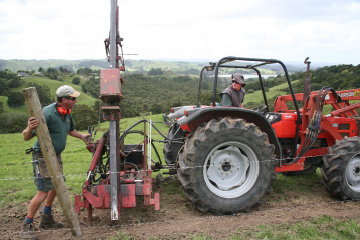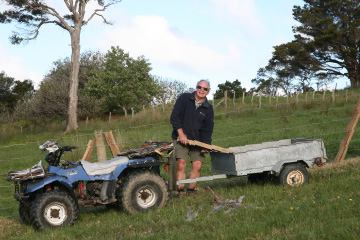Old school fence underlined the scale of sediment generation
Colin Hawken was sticking to his guns.

An Entirely Professional Job: Colin Hawken, left, and Russell Brown making short work of the bottom fence—evidence of 100 years of sediment generation having been recently smoothed over. photographer Maree Owston-Doyle
Unless the ground was cut down, he insisted, the new fence he was about to erect would perch unsteadily on the edge of the bank.
The bank had been formed, in the 100-odd years since the Mahurangi Heads West schoolyard was fenced, by the combination of animal traffic and rainfall. At the bottom (northeastern) corner, the soil—the topsoil has long since been lost—was now half a metre lower outside the fence.
Mike Owston-Doyle had responded to the call only to find that the little digger he uses in his commercial plumbing business would have taken until Christmas—almost literally—to shift the quantity of dirt involved.
Mike’s lateral and typically pragmatic suggestion was that Colin should simply drive the posts in deeper—the cattle were not going to jump the combined height of the bank and the lower fence, he pointed out.
But Colin was adamant—that is not the way he’d ever fenced, and he wasn’t about to start cutting corners here.
Mark Hallet arrived, like a bear with a sore… arm, actually after wrestling with a loaded barge. In any event, his Mark’s seriously big digger was tied up on a city job.
‘Its alright,’ said Colin, ‘Ross is on his way.’
Ross Tolhorf arrived; much Pūhoiian roister doister ensuing.
There was no question of payment but numerous claims and counter claims as to who owes whom the bigger favour, are ultimately settled in favour of Ross, and in the accustomed currency.
Ross and utility disappear, only to reappear as Ross and tractor—surprisingly quickly, but they have travelled from Hungry Creek cross-country.
In short order Ross’ grader blade sculpted the land to Colin’s prescription. Ross then demonstrated how to remove a line of old concrete posts without leaving the tractor seat. A profusely sweating editor labouring to pull each post clear before the next is plucked from the ground with the corner of the grader blade. In spite of their antiquity, the reinforcing steel of the now-mangled posts shone like new.
From an archaeologist’s or soil conservator’s viewpoint the new profile is a travesty—the previously stark record of sediment generation has been disguised. All a little ironical given that the funding for the materials, and the indigenous plants the fence was to protect, had been provided to help raise awareness of sediment generation.
But nobody could begrudge the fencers, who donated the use of their equipment and much of their labour, the satisfaction of a smart, professional job. That professionalism was personified by 18-year-old Russell Brown, who Colin had only recently employed, volunteering to batten the fence in his own time—probably suspecting that if left to volunteers, apart from being extremely tedious work without the aid of a stapling gun, would not have been the crisp job he competed over two subsequent Saturdays.
The project was to fence three sides of the hall property, prompted by the need to keep stock off the newly-established indigenous plants.
But when that was completed, bar the battening, Colin perused the road boundary fence, a tangle of kikuyu and rusted barbed wire hanging slack between characterless concrete posts, and declared: ‘Why don’t we just do it now?—and then its done!’

Answering the Call: Volunteer Cluny Macpherson not only laid out all the new battens, he helped pull the old fence and, almost single-handed, cleaned up the remnants of old. photographer Maree Owston-Doyle
A quick call to the project manager.
‘Well the thing is, we don’t have the money—what with the extra flooring costs.’
‘Colin is not charging us!’
‘Oh Christ, just do it then!’
With the new fence completed, nicely setting off the restored Mahurangi West Hall, all that remains is how best to make the link between the century of grazing that formed a half-metre bank, and a harbour half-choked with sediment.
